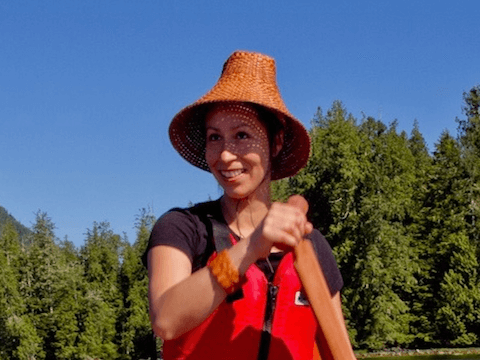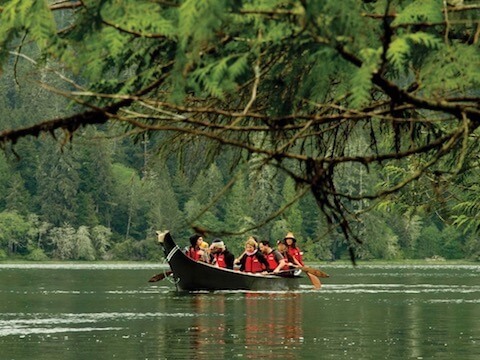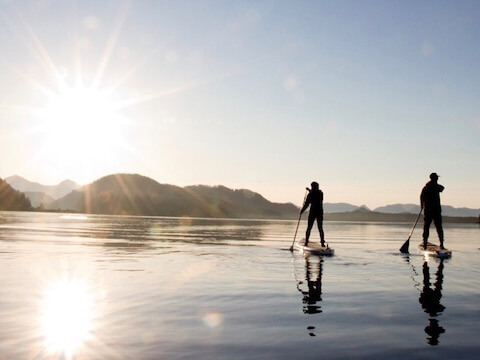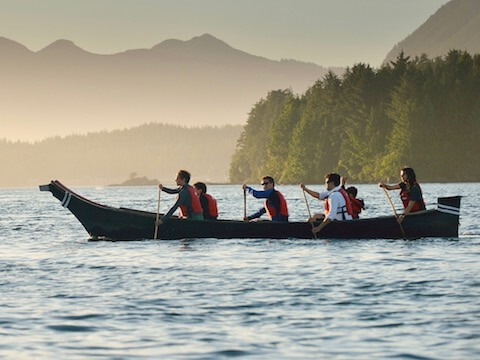David Suzuki's Blog, page 9
May 25, 2017
Is it time to celebrate plans for largest marine protected area in Canada?

(Credit: John Hillard via flickr)
The federal government deserves a pat on the back for its announcement on May 24 that it plans to protect 140,000 square kilometres of ocean off the west coast of Vancouver Island, stretching out to the western edge of Canada's 200-mile exclusive economic zone. Covering an area twice the size of New Brunswick, this proposed marine protected area would encompass spectacular seamounts (underwater mountains) and hydrothermal vents, which have important ecosystem functions.
The David Suzuki Foundation and other organizations are calling for Canada's government to meet its international commitment to protect a least 10 per cent of its marine area by 2020.
Although this newly proposed large offshore protected area will move Canada toward that goal, it will not protect the most threatened species and marine habitats on the Pacific Coast. With little industrial activity or fishing in the area, it's unlikely that current industrial activities will need to be curtailed. The problem? Protecting a large offshore area that faces few threats could siphon off limited resources urgently needed to protect threatened and at-risk species, such as southern resident killer whales, and their habitat.
First Nations, the provincial government and stakeholders in B.C. are immersed in marine planning and marine protected area network establishment processes that show great promise to protect biodiversity over a broader range of threatened environments on B.C.'s central and north coast, known as the northern bio-shelf region. These planning initiatives need ongoing support and a fair share of the limited capacity government agencies have to establish marine protected areas.
So, kudos to the feds for moving Canada closer to marine protection targets. We hope the next announcement for marine protection will focus on marine plans and broad consultation in areas of the coast threatened by industry, and that new plans will support Indigenous cultural values and interests.
Hey! Want more DSF? Join David Suzuki on Facebook

May 24, 2017
Join us for World Environment Day 2017

On June 5, Canada is hosting World Environment Day and Blue Dot is planning a series of actions in the lead up to this international event!
Hey! Want more DSF? Join David Suzuki on Facebook

Clean Fuel Standard Recommendations to the Government

Fuelling Canada's clean energy future: The David Suzuki Foundation and Queen's University recommendations to the Government of Canada's clean fuel standard consultation.
Hey! Want more DSF? Join David Suzuki on Facebook

May 23, 2017
People just like you are building a better future for us all

Tsimka Martin guiding a traditional Tla-o-qui-aht canoe tour for T'ashii Paddle School.
"In a world of more than seven billion people, each of us is a drop in the bucket. But with enough drops, we can fill any bucket." ~ David Suzuki
Across the nation, innovative people from every walk of life are promoting biodiversity, climate solutions and the right to a healthy environment where they live. Each month, Queen of Green will feature someone using their unique gifts to build a greener future for everyone.
Meet Tsimka Martin, owner of T'ashii Paddle School in Clayoquot Sound, B.C. who's building bridges between people, place and culture:
What inspired you to start T'ashii Paddle School?
For eight seasons, I worked as a guide for my sister Gisele's cultural canoe company, Tla-ook Cultural Adventures. I'd just finished secondary school. I developed leadership and public speaking skills, and got to be outside!
When TCA closed, Emre (my partner) and I started T'ashii Paddle School. The potential guides among Native youth in my Nuu-cha-nulth community were my biggest inspiration. I want young people in Indigenous communities to have engaging opportunities to grow their leadership skills. Guides learn and practice group management and safety, outdoor trip factors such as weather forecasts and tides, and how to navigate in currents. They become points of contact for visitors, sharing community history and personal perspectives. They can tell stories and have dynamic discussions about Indigenous land relationships or "managing for abundance" practices -- often influencing a shift in guests' perspectives.
Many visitors from other countries don't know about ongoing Indigenous land struggles or the impacts of residential schools until they come out with us. Many Canadians have their first lengthy interaction with a Nuu-chah-nulth person with us. This is a valuable. It's different than reading a book. It sticks because it's real interaction with live human beings who are responsible for helping you get where you need to go.
The fact that people are often physically pushing themselves out of their comfort zone has a big impact -- something to do with memories being more deeply etched during unique or challenging experiences.

(Photo credit: Emre Bosut)
What's your strongest childhood memory of connection to your territory?
There are so many: playing in the woods, being proud to be able to get around in thick forest. Climbing Clutch-i-klee ("stands alone") Mountain in Tla-o-qui-aht territory five years ago was special. My father told me how our ancestors would go up that mountain to spiritually and physically prepare for whale hunting. Two-thirds of the way up I was so tired, I wondered if I would make it. I had bad footwear and an awkward backpack. I thought about the conditioning it would take to climb barefoot, as my ancestors had. I considered asking the others to go ahead without me when a black bear came along behind us, sniffing the air. That helped me continue. The smoked salmon in my backpack was mine! Not his!
Reaching the peak was overwhelming. The incredible steepness dropping away on both sides, the wind blowing up, the feeling of all the work in my body. It was a deeply emotional experience.
What do people take away after a day of paddling with T'ashii?
People email us about how their group had lengthy discussions about the ongoing struggles of colonialism after the tour. Many just take in the living beauty and recharge.
What do you love most about your work?
Witnessing guides find their voices and their leadership selves. How everyone -- guides and guests -- gain from sharing perspectives. Guests often feel hopeful but also have a new sense of the challenges faced by this area and the people. Some guides and guests share songs in the canoe. People often reflect on how the paddling is easier with someone singing. Guests often also tell us that a song brings a different essence and calls one to be present on the tour.

(Photo credit: Emre Bosut)
How has T'ashii affected your community?
We also do stand-up paddle boarding tours and lessons. We've done several free SUP sessions for the Tla-o-qui-aht community at Long Beach and Kennedy Lake.
T'ashii co-owner Emre Bosut is a Red Cross training partner. Many locals now get various levels of first aid training with us. Our cultural canoe tours are the only tour of their kind in this area. We are proud to offer these tours and provide wholesome employment for our community members. The local community has embraced what we offer and that is a good sign.
What advice do you have for creating sustainability initiatives that can shift local economies?
Brainstorm with like-minded people. Strategize, plan and organize. Think about the logistics of what needs to happen and delegate tasks to people who you know can help you. That all can seem daunting. What's important is to begin. Then remember to follow through.

(Photo credit: Emre Bosut)
Do you know someone who deserves recognition for doing exceptional work protecting nature? Nominate a green leader from your community by commenting on this blog or through the Queen of Green facebook
Sincerely,
Nikki Sanchez, a fellow Queen of Green
Hey! Want more DSF? Join David Suzuki on Facebook

Bloor bike lane a boon to business, safety

(Credit: Dylan Passmore via Flickr)
Nine months after Toronto launched its Bloor bike lane, is the project a success? There's much evidence to suggest it is.
A survey released by the city in February shows 64 per cent of resident and business respondents believe the lane provides safety for cyclists while allowing acceptable traffic flow and parking. Nearly two-thirds of motorists say they feel "comfortable" driving next to cyclists now -- compared to just 14 per cent in 2015, before the lane was installed.
The research also found the number of Bloor cyclists has increased 36 per cent, while the number of cars has dropped 22 per cent.
Behind the numbers, of course, are local folks' lived experiences of the project. In recent discussions, they've told me the lane has made Bloor a nicer place to live and a better place to do business.
Ron Koperdraad is manager of the Hot Docs Ted Rogers Cinema, a Bloor Street landmark that screens edgy international documentaries that draw around-the-block crowds. He describes himself as a commuting cyclist and says he appreciates the new bike lane at a personal level: "I do feel safer now on Bloor." He also likes the fact that the lane links with other bike routes to form a downtown network. "The other day I had a meeting at the Art Gallery of Ontario, " he recalls. "Afterwards, I took bike lanes the whole way back to the cinema."
Like many downtowners, Koperdraad is a cyclist some days and a motorist others. When behind the wheel, he doesn't find the new infrastructure onerous. "I drive as well," he explains, "and don't find traffic grinds to a halt when the bike lane begins."
He also sees advantages for his theatre. The lane "benefits those who choose to bike to the cinema," he says, adding that the cycle track has made the neighbourhood more vibrant. "Before the bike lane went in, lots of cyclists were avoiding Bloor. But with the lane in place more cyclists are now in front of our business."
Tammy Thorne is publisher of dandyhorse, an artfully designed cycling advocacy magazine that began in 2008. She's also an expert on urban biking and a resident of Toronto's Annex neighbourhood, which the new bike lane borders. She says Bloor is an excellent location for cycle tracks. "It's a cultural street with lots of shopping and walking. It's not a highway."
Thorne is excited by the roadway's transformation. "You never would've seen kids cycling on Bloor without the bike lane," she observes. "I recently saw a seven-year-old there. That never would've happened before." She also believes the lane is a boon to elderly motorists. "I've driven Bloor with my dad, a retired farmer from Peterborough," she says. "The bike lane has made a huge difference for drivers like him. He knows really clearly where the bicycles are and where the cars are. It's a lot safer."
Like many commentators, Thorne feels the lane can help local retailers flourish. Biking on Bloor is now a "much more pleasant experience," she explains, so "many cyclists are changing their route. Lots of them are bringing their business to Bloor because of the lane."
That sentiment is shared by Matt Languay, owner of the Basecamp Climbing gym, which is located near the bike lane's western extremity. Now in its second year of operation, Basecamp hosts 200 to 300 climbers a day and its pool of customers is expanding steadily. Languay believes some of that growth is due to the new lane. It's "been a huge, huge help getting our members" to the facility, he says. "Getting here before the bike lane was much more dangerous."
This fall, city council will debate whether to dismantle the new infrastructure -- which is only a pilot -- or make it permanent. Cyclists favour the latter option -- and, as research and on-the-ground discussion suggest, so do many drivers and businesspeople.
Take Action: Protect the Bloor Bike Lane
Hey! Want more DSF? Join David Suzuki on Facebook

May 18, 2017
Increased awareness is key to resolving the climate crisis

(Just Cool It!: The Climate Crisis and What We Can Do, published by Greystone Books)
Most people understand that human-caused climate change is a real and serious threat. True, some still reject the mountains of evidence amassed by scientists from around the world over many decades, and accepted by every legitimate scientific academy and institution. But as the physical evidence builds daily -- from increasingly frequent and intense extreme weather events like droughts and floods to disappearing polar ice to rising sea levels -- it takes an incredible amount of denial to claim we have no reason to worry.
Climate change isn't an easy or pleasant subject, and massive efforts by the fossil fuel industry and its supporters to sow doubt and confusion have made it harder for people to grasp. With all the information out there, it's not always easy to distinguish between analysis based on rational, peer-reviewed evidence and propaganda from industry and deniers. But if more people truly understood the enormity of the crisis, we'd be engaged in an all-out effort, comparable to those undertaken during world wars, to reduce the threat.
That's why David Suzuki Foundation senior editor Ian Hanington and I wrote Just Cool It!: The Climate Crisis and What We Can Do. The book provides a clear and comprehensive overview of global warming, climate science and solutions. We examine the science's history, from 1824 when natural philosopher Joseph Fourier discovered the greenhouse effect -- although he didn't call it that -- through to the discovery of feedback loops, and up to the present, following the 2015 Paris Agreement, which was based on the current evidence outlined in the Intergovernmental Panel on Climate Change's Fifth Assessment Report.
The book then delves into climate consequences and impacts -- from extreme weather to melting Arctic ice and ocean acidification to species extinction and impacts on human physical and mental health to the refugee crisis and more.
With extensive knowledge about climate change and its consequences and impacts, one has to ask why we're moving so slowly to confront such an urgent problem. We're already in a troubling state and it will quickly get worse if we fail to tackle it head-on. The book's next section explores some reasons behind this lack of resolve. Although there's progress in many areas, we still have to come to terms with outmoded ways of thinking and living that prevent us from acting in our own best interests. We also have to deal with issues like population growth and industrialization in the developing world. And we're still up against wealthy, powerful interests that would like us to ignore the issue so they can continue to reap enormous fossil fuel profits.
Despite the barriers, there's a wide range of solutions, and most of the book focuses on those. Some are already in place and some are being developed. Some show more promise than others, and some have their own pitfalls. Ultimately, though, this is what gives us hope. As we point out, no single technology, action or idea will get us out of this mess. It will take concerted efforts from individuals, governments at all levels and people in every sector, from agriculture to science and technology.
The benefits of many solutions go beyond their climate implications. Burning less coal, oil and gas helps the climate but also cuts pollution, which protects human health and brings health-care costs down. Those who are able to walk, bike or take transit instead of driving will improve their physical and mental health (avoiding gridlock aggravation, for example) and save significant amounts of money. Improving agricultural methods can increase the carbon stored in soils and plants and prevent loss of fertile soils, which is also a serious problem for humanity.
Many individual solutions, especially, come with added benefits. There's so much people can do in their personal lives: drive less, eat less or no meat and dairy, be more energy efficient, reduce waste, buy less and divest from fossil fuel companies among them. But individual actions alone won't resolve the crisis. That's why the most important way to help keep the world healthy and habitable for humans is to get informed and get involved. We hope this book will encourage more people to join the growing movement for a livable future!
Hey! Want more DSF? Join David Suzuki on Facebook

Federal carbon price a milestone in Canada's efforts to fight climate change
VANCOUVER -- The federal government's decision to implement a national carbon price is a landmark incentive for producing cleaner energy in Canada.
"This decision was a long time coming," said David Suzuki Foundation science and policy director Ian Bruce. "We've seen effective carbon pricing in B.C., Quebec and California. Now, with the entire country on board, the federal government has laid the foundation for a forward-thinking climate-action strategy."
The national carbon price supports the economy and public health, Bruce said. "Putting a price on carbon pollution gives an incentive for all Canadians -- individuals, families, communities and businesses -- to be part of the solution."
Since B.C.'s carbon tax was introduced in 2008, the province has seen more than 8,400 British Columbians employed in the clean technology sector. Research suggests that since B.C.'s tax was introduced, British Columbians have paid less on gasoline, on average - thanks to decreased consumption and more efficient use, incentivized by the price on carbon. As the province's gasoline prices increased by approximately 1 per cent (or $0.01 / L), fuel consumption decreased by 1.6 per cent.
"Going green will be much easier now," Bruce said. "Our research shows that renewable energy will become more affordable, spurring innovation, growing Canada's clean technology economy and making the air we all breathe cleaner."
Although the decision marks a milestone in Canada's climate action strategy, Bruce said further details are still forthcoming and the price on carbon will not be effective on its own.
"This is a big, foundational piece in Canada's climate action strategy, but we need to ensure that the federal government enacts other solutions that are also key to our country's climate plan, such as prioritizing cleaner transportation and phasing out subsidies to fossil fuel companies, which act as a negative carbon price and negate this hard-fought progress."
The carbon price will start at $10 per tonne in 2018, increasing by $10 each year until 2022.
- 30 -
Media contacts:
Brendan Glauser
David Suzuki Foundation
604-356-8829
bGlauser@davidsuzuki.org
Emily Fister
David Suzuki Foundation
604-440-5470
eFister@davidsuzuki.org
Hey! Want more DSF? Join David Suzuki on Facebook

May 16, 2017
Thousands of Canadians call for action to protect monarch butterflies

David Suzuki Foundation campaign asks feds to fund research, conservation
OTTAWA, May 8, 2017 -- The David Suzuki Foundation launched a campaign this week calling on the federal government to take action to help monarch butterflies. Over the past 20 years, approximately 90 per cent of the monarch butterflies that migrate from Mexico to Canada have disappeared. After a couple of years of modest improvement, the monarch population dropped by 27 per cent last year.
Supported by more than 8,500 Canadians who sent letters to their members of Parliament and the federal environment minister, the David Suzuki Foundation is calling for immediate funding for research and conservation efforts in Canada. In 2015, government agencies in the United States allocated more than $20 million and set a national target to restore 200,000 hectares of monarch habitat.
"The U.S. responded to the monarch butterfly crisis by investing millions and setting ambitious targets," said Jode Roberts, senior strategist at the David Suzuki Foundation. "In Canada, almost all of the meaningful action has come from citizens and groups that have been planting milkweed and native wildflowers in support of monarchs. It's time for the federal government to do its part."
In December 2016, scientists from Canada's Committee on the Status of Endangered Wildlife in Canada (COSEWIC) recommended that monarchs be listed as an endangered species under the federal Species at Risk Act. Despite this recommendation, the federal government has yet to legally protect monarchs.
Minister of Environment and Climate Change Catherine McKenna became a passionate advocate for monarch recovery recently. Following a visit with her children to the alpine Mexican forests where monarchs overwinter, she wrote a heartfelt article calling on Canadians to act before monarchs go the way of passenger pigeons and buffalo.
"Programs can be quickly created in Canada to fund new research and conservation efforts, based on the U.S.'s remarkable progress," said Rachel Plotkin, science projects manager at the David Suzuki Foundation. "Targets can be set for planting milkweed and other butterfly-friendly species in thousands of yards, parks, roadsides, infrastructure corridors and natural spaces."
For more information, please visit www.davidsuzuki.org/monarchs contact:
Jode Roberts, David Suzuki Foundation, 647.456.9752 jroberts@davidsuzuki.org @joderoberts
Hey! Want more DSF? Join David Suzuki on Facebook

May 15, 2017
Four edible "weeds"

Nutritious and delicious Miner's lettuce salad (Photo Credit: Brendan Harris)
As spring blooms, people often rid their yards and gardens of "weeds" in preparation for a fresh start. But a "weed" is a valueless or undesirable plant. And that's a matter of perspective!
Enrich your diet with these four edibles that are as delicious as they are common. (You'll also avoid harmful herbicides and support beneficial insects.)
Chickweed
This spade-leafed plant has small white flowers. Tastes like spinach. High in beta carotene, calcium, magnesium and zinc. Look for it at the edges of pavement, garden beds and gravel areas. At night, it "sleeps" by folding its leaves over the buds and new shoots. Use it to make delicious chickweed pakoras!
Dandelion
Find these bright yellow flowers in fields, lawns and garden edges. They're high in Vitamins A, B, C and D, as well as iron, potassium and zinc. Every part of the plant is edible, from the roots to the blossom! Add blossoms to brighten up any salad. Try this recipe for dandy tempura.
Miner's lettuce (a.k.a winter purslane)
Find this satellite-shaped plant in most backyards and parks, in shady areas near fences, gardens and at the base of trees. Named for the nutrition it gave early miners struggling to find food, it contains high levels of chlorophyll and vitamin C. Try this healthy spin on egg salad.
Wood sorrel
This dainty plant resembles clover. Look for it along garden edges, fences or your home's exterior walls. Its heart-shaped petals have a bright, citrus flavour and are high in vitamin C. Try this sorrel smoothie recipe and make enough to share.
Share your favorite recipes for "weeds" in the comments and I'll compile them for a future blog. Happy harvesting!
Sincerely,
Nikki Sanchez, a fellow Queen of Green
Hey! Want more DSF? Join David Suzuki on Facebook

May 12, 2017
Finding Solutions - Spring 2017

Finding Solutions is our quarterly report to you -- showing your donations at work in our recent victories and campaigns. Plus, it's full of tips, news, recommended books and movies, and ways you can help the environment in your everyday life.
Hey! Want more DSF? Join David Suzuki on Facebook

David Suzuki's Blog
- David Suzuki's profile
- 247 followers



